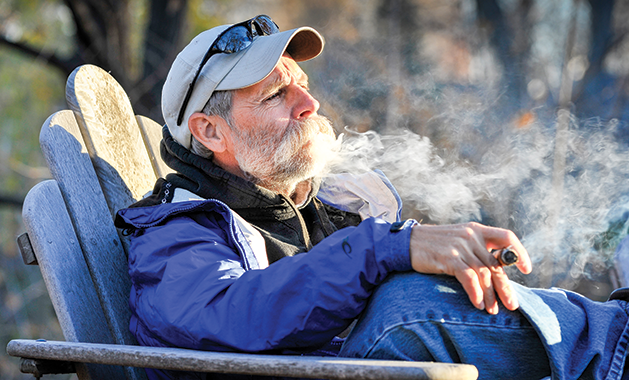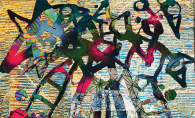
Jim Douglas is a storyteller—through his career as an award-winning photojournalist, writer and photographer, and in memories he shares with passionate narratives. To be with Douglas requires one to pause and employ as many senses as required to travel alongside him during his stories.
While Douglas is a master of the spoken word and an accomplished photojournalist, his own experiences are also candidly reflected, including his days growing up on a Wisconsin farm, serving in Vietnam, traveling the world as a photojournalist and developing a career as a lifestyle photographer.
Shorewood resident Douglas, who occasionally refers to himself as “Seamus Gordon McCulloch-Douglas” (a nod to his heritage), is fiercely proud of his Scottish and Irish lineage, which influenced his manner of speech as much as his approach to life. “It influenced how I expressed myself and how I wrote,” he says. His Irish mother recognized Douglas’ artistic talent when he was just a wee lad, but he discovered his aptitude for photography when he was a high school senior and his health prevented him from remaining on the wrestling team. When the state tournament rolled around, the local newspaper employed Douglas to take photos of the event. And the rest, as they say, is history.
Ironically, Douglas’ eyes, which have faithfully served him over the years, prevented him from attending the U.S. Naval Academy—not having 20/20 vision was the stumbling block. But Douglas enlisted in the Navy, landed at Naval Station Great Lakes and, despite wanting to be a photographer, was sent to train in naval intelligence. “It was the best thing that happened to me,” he says. Douglas served in Vietnam from 1964 to 1966, supporting Navy combat pilots.
After the military, Douglas attended the University of Wisconsin-Green Bay, where, true to form, he dove headlong into art and journalism. A career as a television news photographer beckoned, and after a stint at WLUK-Green Bay, it was off to WHIO, a CBS affiliate in Ohio. “It was another fruitful step along my journey,” he says. KARE 11 was his eventual career home. “The best decision I ever made was to come here,” he says. Douglas would go on to receive five Emmy Awards for pieces for PBS and NBC News. In 1985, Douglas was named National Photographer of the Year and was a finalist for the same award the following year. He was nominated for a Peabody Award for his body of work in 2001.
His career found him shooting in Paris fashion houses, the Forbidden City in China, the Bavarian Alps, Oktoberfest in Germany and the Kehlsteinhaus (Adolph Hitler’s retreat). Closer to home, stories led him to a St. Paul convent, where he documented the lives of the Sisters of St. Joseph of Carondelet, including one sister as she sat at another’s bedside to “accompany a friend on the journey of death,” he recalls.
Douglas detailed a 17-year-old boy’s battle with muscular dystrophy, which required the teen to lay bare his “68-pound twisted frame” for the camera. “We talked about the truth of visual storytelling,” Douglas says, explaining the courage required of the teen. One of the scenes includes a poignant moment as the boy’s mother prepares him for a morning bath—strikingly reminiscent of W. Eugene Smith’s 1971 photograph of Ryoko Uemura, as she held her daughter, Tomoko, over a bath. (Tomoko had suffered the effects of mercury poisoning that ravaged the people of Minamata, Japan.) “That just moved me,” Douglas says.
Contrary to his natural inclination, there are some stories that Douglas finds difficult to offer the universe. “To this day, Vietnam is a tough subject for me,” he says. Perhaps this is why it’s taken Douglas so much time to finish his first novel, Wollers’ Hill. (“It’s predicated on real people and real events,” he says.) It might also have contributed to his desire to document the story of two Vietnam veterans, even if it meant having an AR-15’s magazine emptied at his feet upon meeting the men. (It was one of the vet’s way of testing Douglas’ mettle—and, perhaps, his motivation.)
It is only in talking about his return to Coleman High School, where his Scottish father, James Robert Douglas, taught science and served as the wrestling coach, that the spark in Douglas’ eyes diminishes. At Coleman in 2000 to document the five Novak brothers, who were all on the school wrestling team, Douglas returned to his late father’s biology classroom, where he taught until his death in 1970. “I sat down and cried,” he says, his eyes moist with memory of the father who influenced much of his life.
There are others who impacted Douglas. “I drew inspiration from both television news photographers and still shooters,” he says. “While in college and in the years that followed, I immersed myself in the work of some of the world’s finest image makers. My growth as a visual storyteller was predicated on learning from the best and applying that new knowledge to my own work. Truth is, after four decades, I’m still a student of the arts.”
In 2014, it was time for Douglas to call it a day at KARE. “I’d done it. I’d done it for so long it became redundant,” he says. “It was time to leave.” Douglas explains, “My broadcast career spanned 40 years and in that time frame, I traveled the globe, photographing and telling the stories of fascinating people. I [define] my job in simple terms; I made little movies that reached millions of viewers,” he says. “However, when it was time to step away from television news, there was no question that I would continue to shoot. I simply traded a video camera for two Nikon still cameras.”
Douglas turned his focus to lifestyle photography, where he finds fulfillment in his latest career incarnation. He can be found shooting near Lake Minnetonka, in local natural areas, off a road or around an abandoned home, but mostly he’s in the midst of wedding festivities. “Today, perhaps nothing is more gratifying than creating photo essays with a humanistic perspective, and for me, the ultimate of the genre is wedding photography,” Douglas says. “I love the pageantry and the opportunity to tell a couple’s story in a series of personal and captivating images.
“There’s never an assignment that is a drag or a bore,” Douglas says. The opportunity to create is captivating, he says. “That’s the challenge, [and I’m] enjoying the hell out of it.” His gusto isn’t lost on his clients. “They can see my enthusiasm straight away,” he says.
“There’s a reason why he’s award-winning,” Jennifer Maloney says. “He has an eye for capturing moments.” Douglas photographed Maloney’s wedding. The couple hired Douglas due to his talent for finding moments, not poses. “I wanted more to capture the essence of what we were doing,” Maloney says.
While Douglas’ career dance card is full, there’s always room for more shots to highlight, more stories to explore. Scotland beckons, so Douglas can document family history. Until his travels take him there, Douglas continues to find inspiration and gratitude here and now. “I’m fortunate that my passion for my craft is as intense today as it was during a long and wonderfully rewarding career,” he says. “I feel I’m blessed that I can look forward to every new day with its photographic possibilities. That’s a gift I treasure. Not everyone is so fortunate.” Douglas, as he often does, circles back to his boyhood in Wisconsin. “How many opportunities can a farm boy have?” he asks.









